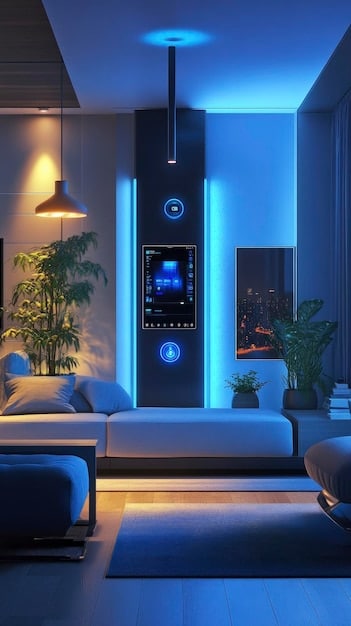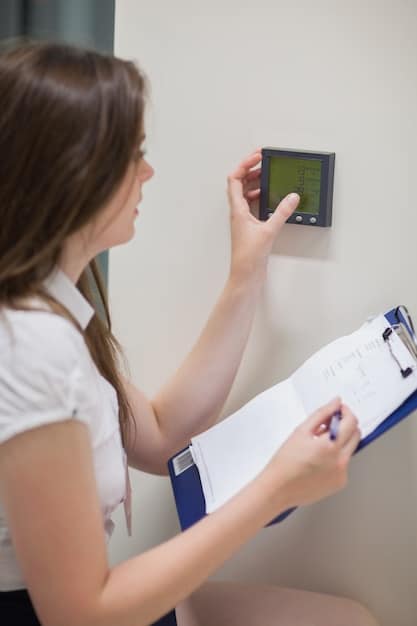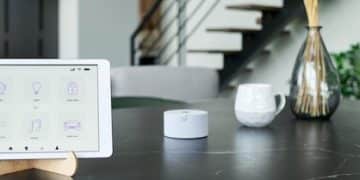Smart Home Sensors in 2025: Unlocking New Data Insights

Smart home sensors are poised to evolve significantly by 2025, offering deeper data insights into our daily lives, from personalized health monitoring to optimized energy consumption and enhanced security measures, transforming how we interact with our living spaces.
The realm of smart homes is perpetually expanding, and at its core lies the evolution of smart home sensors. As we approach 2025, these sensors are not just becoming more ubiquitous; they’re also set to unlock a treasure trove of new data insights. The Evolution of Smart Home Sensors: What New Data Insights Will They Provide in 2025? promises to revolutionize how we interact with our homes and daily lives.
Understanding the Current State of Smart Home Sensors
Before we delve into the future, it’s crucial to understand the current landscape of smart home sensors. These devices have already made significant inroads into our lives, offering convenience, security, and energy efficiency.
Currently, smart home sensors primarily focus on basic functionalities such as:
- Monitoring temperature and humidity levels.
- Detecting motion for security purposes.
- Controlling lighting and appliances remotely.
These sensors, while useful, often operate in silos, providing limited insights beyond their immediate functions. However, the next generation of smart home sensors promises a more integrated and intelligent approach.

Anticipated Advancements in Sensor Technology by 2025
Looking ahead to 2025, several key advancements in sensor technology are expected to drive the evolution of smart home capabilities. These advancements will not only enhance the accuracy and reliability of sensors but also expand the range of data they can collect.
Improved Sensor Resolution and Accuracy
One of the primary focus areas is improving the resolution and accuracy of sensors. This will enable more precise monitoring of environmental conditions, human activity, and appliance performance.
Integration of AI and Machine Learning
The integration of artificial intelligence (AI) and machine learning (ML) algorithms will allow sensors to analyze data in real-time and provide more meaningful insights. This includes predictive maintenance for appliances, personalized comfort settings, and proactive security alerts.
- Predictive maintenance for appliances based on usage patterns.
- Personalized comfort settings based on individual preferences and real-time environmental data.
- Proactive security alerts based on anomaly detection.
New Data Insights Emerging from Advanced Sensors
The enhanced capabilities of smart home sensors in 2025 will unlock a wealth of new data insights, transforming our homes into intelligent living spaces that adapt to our needs and enhance our well-being.
These data insights can be broadly categorized into:
- Personalized Health Monitoring
- Enhanced Energy Efficiency
- Advanced Security Measures
Let’s explore each of these categories in detail.
Personalized Health Monitoring in Smart Homes
One of the most promising applications of advanced smart home sensors is personalized health monitoring. By integrating sensors that can track vital signs, sleep patterns, and activity levels, smart homes can become proactive health management tools.
Tracking Vital Signs and Sleep Patterns
Sensors embedded in mattresses, wearables, and even bathroom fixtures can monitor vital signs such as heart rate, respiratory rate, and body temperature. These data points can be used to identify potential health issues early on.
Analyzing Activity Levels and Movement Patterns
Motion sensors, combined with AI algorithms, can analyze activity levels and movement patterns to detect changes in mobility, balance, and gait. This can be particularly beneficial for elderly individuals living alone, as it can help prevent falls and other accidents.

Enhancing Energy Efficiency Through Data-Driven Automation
Smart home sensors are also playing a crucial role in enhancing energy efficiency. By collecting data on energy consumption patterns, occupancy, and environmental conditions, these sensors can enable automated systems that optimize energy usage.
Optimizing HVAC Systems
Smart thermostats, combined with occupancy sensors and weather data, can optimize heating, ventilation, and air conditioning (HVAC) systems to minimize energy consumption while maintaining comfortable indoor temperatures.
Controlling Lighting and Appliance Usage
Smart lighting systems can automatically adjust brightness levels based on ambient light and occupancy, reducing energy waste. Similarly, smart plugs can monitor appliance usage and turn off devices when they are not in use.
By analyzing this data, homeowners can identify areas where they can reduce energy consumption and save money on their utility bills.
Strengthening Home Security with Intelligent Sensors
Security remains a top priority for homeowners, and smart home sensors are becoming increasingly sophisticated in their ability to detect and respond to potential threats.
Advanced Intrusion Detection
Beyond traditional motion sensors, advanced intrusion detection systems can now analyze sound patterns, vibration signatures, and even thermal imaging to identify potential break-ins.
Real-Time Monitoring and Alerts
Smart security cameras can stream live video footage to smartphones or tablets, allowing homeowners to monitor their properties remotely. These systems can also send real-time alerts when suspicious activity is detected.
- Integration with local law enforcement for faster response times.
- Remote control of door locks and alarm systems.
- Facial recognition technology to identify authorized individuals.
These advanced security measures provide homeowners with greater peace of mind and control over their home security.
| Key Point | Brief Description |
|---|---|
| 🩺 Health Monitoring | Sensors track vital signs and sleep patterns for personalized health insights. |
| 💡 Energy Efficiency | Data-driven automation optimizes HVAC, lighting, and appliance usage to reduce energy waste. |
| 🔒 Home Security | Intelligent sensors provide advanced intrusion detection and real-time monitoring for enhanced security. |
| 🏡 Predictive Maintenance | AI analyzes sensor data to predict appliance failures and schedule preemptive repairs. |
Frequently Asked Questions
▼
By 2025, smart home sensors will offer more personalized and automated experiences, adapting to your needs and enhancing overall comfort, convenience, and security through data-driven insights.
▼
Key benefits include improved health monitoring, enhanced energy efficiency, and strengthened home security, leading to a more comfortable, sustainable, and secure living environment.
▼
AI and machine learning enable sensors to analyze data in real-time, providing predictive maintenance, personalized comfort settings, and proactive security alerts based on learned patterns.
▼
Smart home sensors can collect data on vital signs, sleep patterns, activity levels, and movement patterns, offering valuable insights into overall health and wellness.
▼
Smart home sensors optimize HVAC systems, control lighting, and monitor appliance usage to reduce energy waste, leading to lower utility bills and a more sustainable lifestyle.
Conclusion
As we approach 2025, the evolution of smart home sensors promises to unlock a wealth of new data insights, transforming our homes into intelligent living spaces that adapt to our needs and enhance our well-being. From personalized health monitoring to enhanced energy efficiency and advanced security measures, these sensors are poised to revolutionize how we interact with our homes and daily lives.





